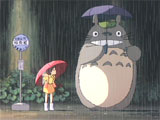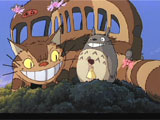

Quick Links:
My Neighbor Totoro (Tonari no Totoro)
Childhood is a magical time of life, where all the stories we hear are real and the world just seems like a bigger place. At least, I think so. I don't remember very much of it, so I make most of it up. I suppose a lot of us gain better childhoods in this way when we grow up, but something always gets left out. The feelings are still there, but how they got there in the first place becomes a great mystery. Mr. Hayao Miyazaki suggests through his 1988 film, My Neighbor Totoro that the missing link is a giant furball with whiskers and big ears that lives in the forest. That's as good a guess as any!
Likewise, it's a mystery as to why My Neighbor Totoro is so appealing, even to adults. It is unquestionably a film made for children, as evidenced by the fluffy animal characters and the mere cursory role of the adult characters. The lives of sisters Mei and Satsuki Kusakabe are charming in their simplicity, but adult life is not hopelessly complicated. No, it is through some intangible relationship that I am drawn to this film, and perhaps that's the whole point - our feelings exist to us, but aren't particularly in the realm of the "real".
That's not to say that the film divorces itself from reality - quite the opposite. The circumstances that affect the two sisters are cruelly real. Throughout the film, their mother is is the hospital, and their father has assumed their complete care. The opening of the film shows the family moving to a rural area, presumably to give Mrs. Kusakabe a more natural setting in which to complete her recovery (when she is able to leave the hospital). The subject of her condition comes up here and there, but the majority of the film is about Mei and Satsuki's magical encounters with their furry neighbor who lives in the huge camphor tree by their house.
In a way, Totoro fills in for the girls' mother. He lets Mei visit when Satsuki's at school and her father is buried in books, and he visits Satsuki when Mei is asleep and their father is late in getting home. He seems to show up precisely when they need him to. Time spent with Totoro and his friends (like the cat that's a bus...or is it a bus that's a cat?) is fun and smiles, for the girls and for the viewer.
Mr. Joe Hisaishi scored this movie, and it is to me his best work on a Miyazaki film (though the score for the more recent Spirited Away is excellent as well). Not only does the music for Totoro blend beautifully with the film, it's unforgettable. The opening and ending songs (Sanpo and Tonari no Totoro) are particularly catchy, perhaps because the lyrics are simplistic and easy to sing along with. Now, Mr. Hisaishi is a fan of repetition, and this film is no exception to the rule. The melody of Tonari no Totoro appears in quite a few places, but the film just isn't negatively affected by it as some of the other films (Nausicaä) are. A few memorable one-shot tunes appear in the movie as well, like a cartoonish trumpet number that accompanies the cat bus while he scurries across a field.
My Neighbor Totoro is positively captivating, in the same way that memories of youth command one's attention when they surface. And like those memories, the feelings conjured up by watching the film remain long after the credits roll.
Distributor: Disney Creator: Hayao Miyazaki / Studio Ghibli Released: 1988
Plot: A Character Design: A- Animation Quality: A Music: A Overall: A



